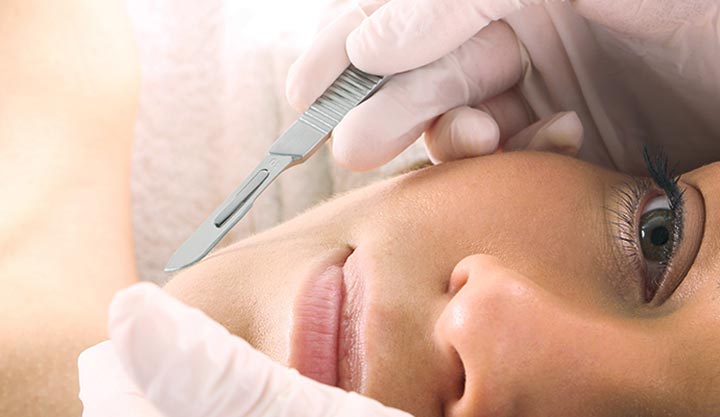Dermaplaning is a minimally invasive procedure that shaves away the top layers of your skin. It can help reduce the appearance of acne scars or pitted skin. Some people get dermaplaning to remove unwanted hair.
Advertisement
Cleveland Clinic is a non-profit academic medical center. Advertising on our site helps support our mission. We do not endorse non-Cleveland Clinic products or services. Policy

Dermaplaning is a minimally invasive cosmetic procedure for your skin. Your healthcare provider uses a special instrument to shave away the uppermost layers of your skin.
Advertisement
Cleveland Clinic is a non-profit academic medical center. Advertising on our site helps support our mission. We do not endorse non-Cleveland Clinic products or services. Policy
Dermaplaning can help reduce the appearance of acne scars or other skin imperfections by revealing newer, undamaged skin. It can make your skin look younger; though, it doesn’t stop the aging process. Some people also get dermaplaning for hair removal. This is only a temporary fix because your hair will grow back.
Most people get the procedure on their face, but you can do it anywhere on your body.
Dermaplaning, dermabrasion and microdermabrasion are all skin resurfacing procedures. Each procedure uses different tools and takes off different amounts of skin. Dermaplaning uses a scalpel (knife) or razor to remove skin. Dermabrasion is a surgical procedure. Microdermabrasion is a nonsurgical procedure that uses an exfoliating blade to sand away your skin to smooth it and remove the appearance of scars.
You may consider dermaplaning if you have skin concerns such as:
Some people with preexisting skin concerns shouldn’t have dermaplaning. Before getting this procedure, talk to your healthcare provider if you have:
Advertisement
A plastic surgeon, dermatologist or cosmetologist might perform dermaplaning. Before the procedure, your healthcare provider will:
Sometimes, your healthcare provider will take photos of the area that needs treatment. The photos help you compare the “before” and “after” results of dermaplaning.
Your healthcare provider will also let you know if there are any special instructions you need to follow before the procedure, such as not smoking for a few weeks. Not smoking may help you heal faster after the procedure.
Dermaplaning doesn’t require general anesthesia, but your healthcare provider might put a numbing cream or spray on your face about half an hour before the procedure.
You might feel a scratching or stinging sensation on your skin, but dermaplaning usually isn’t painful.
Your healthcare provider uses a special instrument called a dermatome to remove hair and skin cells. The tool looks a bit like an electric razor. The dermatome has a small blade that moves back and forth across your skin. It doesn’t make cuts in your skin, but gently shaves off the top layers of skin.
Afterward, they may apply a soothing gel or ointment to your skin to reduce redness, swelling or irritation.
The treatment can last anywhere from a few minutes to an hour and a half. The length of the procedure depends on the size of the area that needs treatment.
Your skin will likely be red, swollen and slightly tender after the dermaplaning procedure. Your healthcare provider may recommend over the counter pain medication to help with any discomfort. If you notice swelling lasts longer than a week or worsens, contact your healthcare provider.
Dermaplaning is generally considered a safe cosmetic procedure. However, it does carry the following risks:
Dermaplaning can help minimize the appearance of acne scars, fine lines, wrinkles and dull skin. The procedure can reveal smoother, firmer and healthier skin.
Recovery is different for everyone in the weeks and months after dermaplaning, but you can expect:
Advertisement
Some people get multiple dermaplaning procedures to achieve their desired results. However, it’s important for your skin to heal completely between treatments. Talk to your healthcare provider to make sure it’s safe to have additional dermaplaning procedures.
Dermaplaning may not reduce the appearance of deep or raised acne scars. Some people need more intense treatments, such as laser surgery.
Contact your healthcare provider if you notice the treated area is:
You may want to ask your healthcare provider:
Dermaplaning is a minimally invasive cosmetic procedure that helps reduce the appearance of acne scars, improves skin brightness and addresses other skin concerns. Some people get microplanning to remove hair. Your healthcare provider uses a special razor to remove the top layers of your skin. Most people can return to normal activities a few weeks after the treatment.
Advertisement
Every day, people see your skin, hair and nails. At Cleveland Clinic, our expert and caring dermatology team will make sure they’re healthy and strong.

Last reviewed on 04/06/2022.
Learn more about the Health Library and our editorial process.